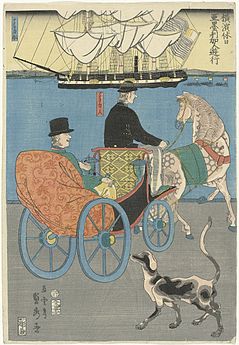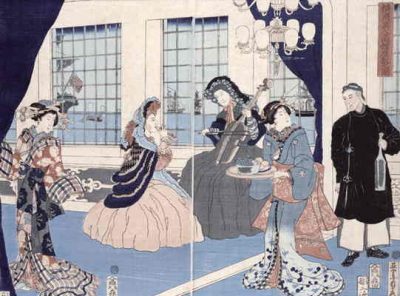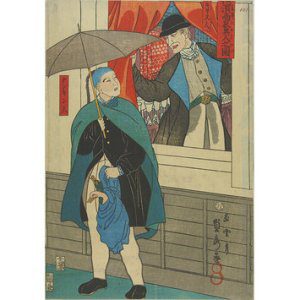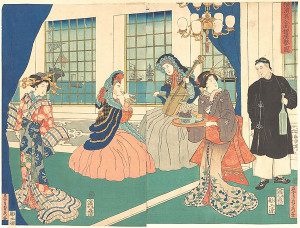Art of Japan and Western Encroachment: Utagawa Sadahide (Gountei Sadahide) and Yokohama-e
Lee Jay Walker
Modern Tokyo Times
Utagawa Sadahide (Gountei Sadahide) witnessed the first years of modernization in Japan that emerged after the 1868 Meiji Restoration. Yet, prior to this dramatic period in Japanese history, the artist Sadahide depicted aspects of Western encroachment. Indeed, while many spectrums of ukiyo-e apply to Sadahide, it is true to say that his Yokohama-e stands out dramatically.
Intriguingly, Sadahide visited Paris in 1867 before momentous times were going to engulf the land of the rising sun. This reality was based on this amazing artist being part of the Tokugawa shogunate’s delegation.
One can only imagine how the International Exposition in Paris inspired an already intrigued artist about aspects of Western culture. Similarly, the sweeping changes taking place in Japan based on the ending of the Tokugawa period in 1868 can be felt by the art of Sadahide. Of course, for Sadahide, this equally applies to convulsions being felt in the death throes of the Tokugawa period and the immediate years that followed.
In another article, I state, “In truth, apart from minor disturbances and limited intrigues within the ruling elites, the Meiji Restoration was a true revolution that was mainly bloodless. Indeed, unlike the French Revolution, the Russian Revolution, and the Iranian Revolution that created enormous convulsions based on the deaths of many, the revolution in Japan was based on modernizing rapidly and preventing the country from being colonized by Western powers.”
Sadahide was born in 1807, therefore, the world he knew during his informative years must have been dramatically different from his final years on this earth. Luckily for Sadahide, he was blessed to have studied under Kunisada. Hence, Sadahide belongs to the famous Utagawa School.
At first, Sadahide especially focused on bijin-ga. However, by the 1830s and 1840s, he began to depict musha-e and landscapes. Interestingly, Sadahide was open to new art themes throughout his artistic career. For example, he covered the First Opium War in China while also depicting neglected art themes in relation to the furthest north of Japan. Therefore, with Western encroachment forcing its hand in Japan from 1854 onwards he now focused on more innocent themes in relation to Yokohama-e.
I stress in a past article, “Despite some enmity that existed because of the changing times, Sadahide appears to focus on positive areas in relation to the mixing of Japanese and foreign nationals. Also, his own eyes witnessed many different features of foreign nationals in relation to facial features. For example, he dispelled the myth of everyone having detailed and sharp noses. Similarly, Sadahide was fascinated by cultural interactions in relation to trade and other areas.”
Not surprisingly, the art of Sadahide was richly appreciated and by the late 1860s his sales were among the highest in Japan. This was especially based on his Yokohama-e because he highlights themes that could be related to by ordinary citizens. After all, just like Paris intrigued Sadahide, the changing face of modern Japan and the impact of Western encroachment intrigued ordinary Japanese nationals.
http://www.art.com/gallery/id–a82727/utagawa-sadahide-posters.htm Utagawa Sadahide
Modern Tokyo News is part of the Modern Tokyo Times group
DONATIONS to SUPPORT MODERN TOKYO TIMES – please pay PayPal and DONATE to sawakoart@gmail.com
http://moderntokyotimes.com Modern Tokyo Times – International News and Japan News
http://sawandjay.com Modern Tokyo Times – Fashion
https://moderntokyonews.com Modern Tokyo News – Tokyo News and International News
http://global-security-news.com Global Security News – Geopolitics and Terrorism
PLEASE JOIN ON TWITTER
https://twitter.com/MTT_News Modern Tokyo Times
PLEASE JOIN ON FACEBOOK





